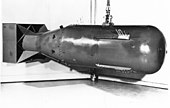
Back محرقة نووية Arabic Holocaust nuclear Catalan Jaderný holokaust Czech Nuklearer Holocaust German هولوکاست هستهای FA Holocauste nucléaire French שואה גרעינית HE Nukleáris holokauszt Hungarian Holokaus nuklir ID Olocausto nucleare Italian

A nuclear holocaust, also known as a nuclear apocalypse, nuclear annihilation, nuclear armageddon, or atomic holocaust, is a theoretical scenario where the mass detonation of nuclear weapons causes widespread destruction and radioactive fallout, with global consequences. Such a scenario envisages large parts of the Earth becoming uninhabitable due to the effects of nuclear warfare, potentially causing the collapse of civilization, the extinction of humanity, or the termination of most biological life on Earth.[1] Global fallout from widespread testing of nuclear weapons has caused until 2000 up to 2.4 million deaths, with some calling this testing genocide or ecocide.
Besides the immediate destruction of cities by nuclear blasts, the potential aftermath of a nuclear war could involve firestorms, a nuclear winter, widespread radiation sickness from fallout, and/or the temporary (if not permanent) loss of much modern technology due to electromagnetic pulses. Some scientists, such as Alan Robock, have speculated that a thermonuclear war could result in the end of modern civilization on Earth, in part due to a long-lasting nuclear winter. In one model, the average temperature of Earth following a full thermonuclear war falls for several years by 7 – 8 °C (13 to 15 degrees Fahrenheit) on average.[2]
Early Cold War-era studies suggested that billions of humans would survive the immediate effects of nuclear blasts and radiation following a global thermonuclear war.[3][4][5][6] The International Physicians for the Prevention of Nuclear War believe that nuclear war could indirectly contribute to human extinction via secondary effects, including environmental consequences, societal breakdown, and economic collapse.
The threat of a nuclear holocaust plays an important role in the anti-nuclear movement and the development of popular perception of nuclear weapons. It features in the security concept of mutually assured destruction (MAD) and is a common scenario in survivalism. Nuclear holocaust is a common feature in literature and film, especially in speculative genres such as science fiction, dystopian and post-apocalyptic fiction.[7]
| Nuclear weapons |
|---|
 |
| Background |
| Nuclear-armed states |
|
- ^ Fee, Elizabeth; Brown, Theodore M. (2004). "Dispelling the Specter of Nuclear Holocaust". American Journal of Public Health. 94 (1): 36. doi:10.2105/AJPH.94.1.36. ISSN 0090-0036. PMC 1449821. PMID 14713693.
- ^ Robock, Alan; Toon, Owen B (2012). "Self-assured destruction: The climate impacts of nuclear war". Bulletin of the Atomic Scientists. 68 (5): 66–74. Bibcode:2012BuAtS..68e..66R. doi:10.1177/0096340212459127. S2CID 14377214. Archived from the original on 2 April 2020. Retrieved 13 February 2016.
- ^ Martin, Brian (1982). "Critique of Nuclear Extinction". Journal of Peace Research. 19 (4): 287–300. doi:10.1177/002234338201900401. S2CID 110974484.
- ^ The Effects of a Global Thermonuclear War. Johnstonsarchive.net. Retrieved on 2013-07-21.
- ^ Martin, Brian (December 1982). "The global health effects of nuclear war". Current Affairs Bulletin. 59 (7): 14–26.
- ^ Detonations, National Research Council (16 November 1975). Long-term worldwide effects of multiple nuclear-weapons detonations. Washington : National Academy of Sciences. ISBN 9780309024181. Retrieved 16 November 2018 – via Trove.
- ^ "Nuclear Holocausts: Atomic War in Fiction | Common Errors in English Usage and More | Washington State University".